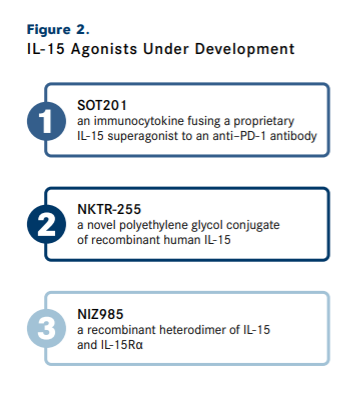Publication
Article
All Eyes Are on IL-15 in Early Phase Studies
Author(s):
A deep dive into IL-15 targeted agents including N-803, those in the pipeline, and the fusion protein SAR445877 which Martin E. Gutierrez, MD, sheds light on.
IL-15, a cytokine of the IL-2 family, is key in the development, proliferation, and activation of immune cells such as natural killer (NK) cells, making it an intriguing target, and the inflammatory cytokine has also been shown to stimulate the expression of immune checkpoint molecules, including PD-1 and PD-L1.1,2 A unique function of IL-15 is that it promotes the maintenance of not only NK cells but CD8+CD44hi memory T cells, thus providing a long-term immune response to pathogens (FIGURE 1).1,3
The fusion protein SAR445877, which combines a human anti–PD-1 antibody with a mutated fusion of human IL-15 and human IL-15Rα Sushi domain, is currently one of many IL-15 targeted agents under evaluation in early phase studies.4
Martin E. Gutierrez, MD

When discussing the development of phase 1 studies to evaluate agents with different targets and mechanisms of action than previously seen, Martin E. Gutierrez, MD, told OncologyLive that “phase 1 clinical trials tend to be rather complex. Historically, they were complex because of the intensity of pharmacokinetic [PK] and plasma volume analyses, but now [it’s because] we intend to introduce efficiency into the drug development [process], which we have, and the FDA has supported that. The complexity of the study design is also [something we] must pay attention to because there are multiple arms and multiple expansions.”
Figure 1 | IL-15

He added that “historically, what used to be a small 50- to 60-patient study has now become a few 100-patient study, interrogating multiple questions during the same protocol. What we do is incredibly important because, [through] this adaptative design, the time line on drug development can significantly improve over time, allowing patients access to these drugs faster.”
Gutierrez is the director of the Drug Discovery/Phase I Program and cochief of thoracic oncology at John Theurer Cancer Center, and a professor in the Department of Oncology at Hackensack Meridian School of Medicine in New Jersey. He is also an associate member of the Thoracic and Gastrointestinal Oncology Program, cochair of the Phase I Diseases Group, and cochair of the Protocol Review and Monitoring Committee at the Georgetown Lombardi Cancer Center in Washington, DC.
Targeting IL-15 With PD-1 in First-in-Human Study
SAR445877 is a fusion protein of high-affinity PD-1 antibody combined with a detuned IL-15. Gutierrez explained that the agent binds to “PD-1–expressing T cells and NK cells, [which] allows the activation of the CD8+ [T cells] and NK cells expressing PD-1 and IL-2/-15[Rβγ].”
“The uniqueness of the IL-15 component combined with PD-L1 is very important,” Gutierrez noted. “Secondly, we have seen some early signals already in some of the not necessarily inflamed tumors, which is very hypothesis generating. But again, we are still early in the process.”
Preclinical data revealed that SAR445877 exhibited increased cytotoxic immune cell recruitment to the tumor microenvironment as well as prolonged survival and tumor clearance, leading to a first-in-human phase 1/2 trial (NCT05584670).5,6 The study is currently enrolling patients with advanced unresectable or metastatic solid tumors to be treated with the anti–PD-1/IL-15 fusion protein in the dose-escalation portion, where the agent will be administered intravenously in 14-day cycles and the maximum tolerated dose (MTD) will be determined. Primary end points encompass safety as well as dose-limiting toxicities (DLTs) in the first 2 cycles.6
“This is a typical phase 1 dose-escalation study with multiple histologies included. Most of what we consider, in some degree, [to be] inflamed tumors—such as lung cancer and melanoma—but also noninflamed tumor cells—such as microsatellite stable colorectal cancer—[are included]. There’s a wide variety of diseases that can be enrolled,” Gutierrez said.
Enrollment criteria for the trial varies for the escalation and expansion portions. Four cohorts will be open in the expansion, including cohort D, a biomarkers cohort in infiltrated tumor types.7 Patients with histologically or cytologically confirmed metastatic non–small cell lung cancer (cohort A), advanced unresectable or metastatic hepatocellular carcinoma (cohort B), and advanced unresectable or metastatic gastric cancer or gastroesophageal junction adenocarcinoma (cohort C) will also be enrolled. Those in cohort C must have a combined positive score of less than 1, nonmicrosatellite instability–high or mismatch repair–proficient disease, and tumors must be HER2/neu negative or positive with HER2/neu status determined locally. Those with HER2/neu-positive tumors must have experienced disease progression on HER2-targeted therapy.6,7
The open-label, multicenter trial’s dose-expansion portion has a primary end point of objective response rate, with secondary end points of time to response, clinical benefit rate, progression-free survival, and safety. Both portions of the study are aiming to evaluate duration of response (DOR), PK, and incidence of antidrug antibodies.6,7
“We’re still in the process of a dose escalation, so we will be finding the DLTs and defining the MTD. With any checkpoint inhibitors, immune-mediated adverse effects [AEs] are important, and we continue to watch them. Some of the bispecific [agents] also can have certain associated cytokine release syndrome, which we have to watch,” Gutierrez explained.
Trial and Error With N-803
N-803 (Anktiva) is a mutant IL-15–based immunostimulatory fusion protein complex that promotes proliferation and activation of NK cells and CD8+ T cells, but not regulatory T cells.8 The QUILT studies have evaluated the first-in-class IL-15 superagonist in several tumor types, with phase 3 studies active in bladder and lung cancers.9 In October 2023, the FDA accepted the resubmission of the biologics license application (BLA) seeking the approval of N-803 in combination with BCG for the treatment of patients with BCG-unresponsive, non–muscle-invasive bladder cancer (NMIBC) with carcinoma in situ with or without Ta or T1 disease. The target action date under the Prescription Drug User Fee Act for the resubmitted BLA is set for April 23, 2024.10
In the May 2023 complete response letter issued by the FDA to the initial N-803 BLA, it was noted the BLA could not be approved in its current form due to deficiencies related to the prelicense inspection of the manufacturer’s (ImmunityBio, Inc) third-party contract manufacturing organizations. The FDA also provided recommendations regarding additional Chemistry Manufacturing and Controls issues and assays that must be resolved.11
Data from the phase 2/3 QUILT-3.032 trial (NCT03022825) which showed clinically meaningful efficacy results supported the N-803 BLA and the final results of the trial were presented at the 2022 American Society of Clinical Oncology Annual Meeting. The complete response rate among patients with BCG-unresponsive NMIBC with carcinoma in situ treated with BCG plus N-803 (n = 82) was 71% (95% CI, 59.6%-80.3%), and the median DOR was 26.6 months (95% CI, 9.9-not reached).8
The safety profile of the combination was tolerable, and investigators noted it was comparable to BCG alone; there were no treatment-related grade 4 or 5 AEs or immune-related serious AEs. Further, 1% of patients experienced treatment-related serious AEs, and treatment-related discontinuation occurred in 2% of patients.
IL-15 Agonists in the Pipeline
Additional IL-15 targeted agents under investigation include SOT201, NKTR-255, and NIZ985, among others (FIGURE 2). SOT201, an immunocytokine fusing a proprietary IL-15 superagonist to an anti–PD-1 antibody, which its manufacturer notes is to directly target T cells, is under investigation in a phase 1 study (NCT06163391). The trial evaluating one of the first IL-15/PD-1–targeting immunocytokines is currently enrolling adult patients with advanced unresectable or metastatic solid tumors.12,13
Figure 2 | IL-15

Additionally, NKTR-255, a novel polyethylene glycol conjugate of recombinant human IL-15, demonstrated promising preclinical activity, supporting the first-in-human phase 1 trial (NCT04136756) of the agent in patients with relapsed or refractory hematologic malignancies.14
Finally, NIZ985, which is a recombinant heterodimer of IL-15 and IL-15Rα, was well tolerated as a single agent and in combination with spartalizumab in dose-escalation (n = 47 and n = 20, respectively) and dose-expansion (n = 36, overall) portions of a phase 1/1b trial (NCT02452268). No DLTs occurred, and the recommended dose for expansion was determined as 1 µg/kg 3 times per week. In the doublet arm, 5% of patients achieved a partial response which included 3 patients with melanoma, pancreatic cancer, and gastric cancer. In the monotherapy arm, 30% of patients experienced stable disease, which was the best response.15
“Immunotherapy, specifically PD-1 and PD-L1 checkpoint inhibitors, has transformed the oncology treatment landscape. But even with the excellent responses, some of them have [demonstrated] in certain histologies and diseases we treat that there is still a large percentage of patients who will relapse or are refractory to [immunotherapy],” Gutierrez said. “Bispecific antibodies such as [SAR445877, which targets IL-15 among others], will fill that unmet need in the population.”
References
- Cai M, Huang X, Huang X, Ju D, Zhu YZ, Ye L. Research progress of interleukin-15 in cancer immunotherapy. Front Pharmacol. 2023;14:1184703. doi:10.3389/fphar.2023.1184703
- Awad RM, De Vlaeminck Y, Meeus F, et al. In vitro modelling of local gene therapy with IL-15/IL-15Rα and a PD-L1 antagonist in melanoma reveals an interplay between NK cells and CD4+ T cells. Sci Rep. 2023;13(1):18995. doi:10.1038/s41598-023-45948-w
- Waldmann TA. The shared and contrasting roles of IL2 and IL15 in the life and death of normal and neoplastic lymphocytes: implications for cancer therapy. Cancer Immunol Res. 2015;3(3):219-227. doi:10.1158/2326-6066.CIR-15-0009
- Bernardo M, Zhang Y, Lu D, et al. Preclinical characterization of SAR445877, an anti-PD-1 antibody-IL-15 mutein fusion protein with robust anti-tumor efficacy as monotherapy and in combination with PD-L1 blockade. Cancer Res. 2023;83(suppl 7):2972. doi:10.1158/1538-7445.AM2023-2972
- Gutierrez M, Garralda E, Calvo E, et al. A phase 1/2, open label, first-in-human, dose escalation and expansion study of SAR445877 administered as monotherapy in adults with advanced solid tumors.J Immunother Cancer. 2023;11(suppl 1):779. doi:10.1136/jitc-2023-SITC2023.0779
- A first-in-human, dose escalation and dose expansion study of SAR445877 in adult participants with advanced solid tumors. ClinicalTrials.gov. Updated February 26, 2024. Accessed February 26, 2024. https://clinicaltrials.gov/study/NCT05584670
- Gutierrez M, Garralda E, Calvo E, et al. A phase I/II, open label, first-in-human, dose escalation and expansion study of SAR445877 administered as monotherapy in adults with advanced solid tumors. Ann Oncol. 2023;34(suppl 2):S646-S647. doi:10.1016/j.annonc.2023.09.2213
- Chamie K, Chang SS, Gonzalgo M, et al. Final clinical results of pivotal trial of IL-15RαFc superagonist N-803 with BCG in BCG-unresponsive CIS and papillary nonmuscle-invasive bladder cancer (NMIBC). J Clin Oncol. 2022;40(suppl 16):4508. doi:10.1200/JCO.2022.40.16_suppl.4508
- ImmunityBio pipeline. ImmunityBio. Accessed February 26, 2024. https://immunitybio.com/pipeline/
- FDA accepts ImmunityBio’s BLA resubmission as complete and sets new PDUFA date. News release. ImmunityBio. October 26, 2023. Accessed February 26, 2024. bit.ly/3UU2fbf
- Form 8-K. United States Securities and Exchange Commission. May 9, 2023. Accessed February 26, 2023. bit.ly/4bTX2GG
- IL-15 superagonist SOT201 immunocytokine. Sotio. Accessed February 26, 2024. bit.ly/3OZo85k
- A study to assess safety and efficacy of SOT201 in patients with advanced/metastatic cancer. Updated December 11, 2023. Accessed February 26, 2024. https://classic.clinicaltrials.gov/ct2/show/NCT06163391
- Miyazaki T, Maiti M, Hennessy M, et al. NKTR-255, a novel polymer-conjugated rhIL-15 with potent antitumor efficacy. J Immunother Cancer. 2021;9(5):e002024. doi:10.1136/jitc-2020-002024
- Leidner R, Conlon K, McNeel DG, et al. First-in-human phase I/Ib study of NIZ985, a recombinant heterodimer of IL-15 and IL-15Rα, as a single agent and in combination with spartalizumab in patients with advanced and metastatic solid tumors. J Immunother Cancer. 2023;11(10):e007725. doi:10.1136/jitc-2023-007725










